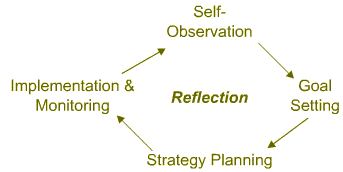Lecture
5
Self-Management: Putting It All Together
Introduction:
Everyone has difficulties and challenges in life. However, not
everyone knows that there are skills and strategies that can
help us control
our reactions to these problems. Those who do, effectively
self-manage their lives. These lectures have provided us with
some necessary
guidance to help us overcome the obstacles of life. So we now
have to decide if we really want to face our problems confidently.
This
is a deliberate decision that we have to make.
What’s involved in this decision?
To review, we know that self-management is a process that refers
to four specific phases. These are self-observation, goal setting,
strategy planning, and implementation and monitoring. We can therefore
expect to carry out each of the phases in a particular order as we
learn to self-manage our lives.
Let’s note that this process of self-management is cyclic.
This means that the skills and strategies of self-management are
interrelated and take place in succession, with one strategy following
the other. We can imagine it like a wheel.
We begin with some initial observations about our skills, abilities
or reactions. Based on this knowledge, we set our goals for a particular
situation. These goals represent what we hope to complete or accomplish.
They are SMART goals in that they are specific, measurable, action-oriented,
realistic, and timely. We, then, develop a plan to achieve our goals.
The next step for us is to implement and monitor our plan. We do
this as we work towards our goals. As we monitor our progress and
achieve our goals, we arrive again at the first phase of self-observation.
However, this time we have learned something new about ourselves,
and this can contribute new information as we make further self-observations.
This starts the cycle over again.
It is important to remember that throughout each phase of the self-management
process, we carefully reflect upon what we are doing and how
the different steps are contributing to a meaningful life. For this
reason,
we can imagine that reflection is the hub or the center of
the self-management wheel. As the hub, it keeps the entire process
together. Indeed,
reflectively thinking about our self-management adds purpose
and meaning to the process, and by extension, to our lives.
Back to top

Throughout the self-management cycle we should remain self-motivated
and self-disciplined.
When our goals are meaningful and we truly want to achieve them,
we remain prepared and ready to take action because we are committed
to improving our life. This helps our self-motivation.
While reflectively monitoring our progress, the decisions that
we reach will guide our actions, even if we need to do something
that we may not want to do. This helps our self-discipline.
Ultimately the decision to self-manage our lives involves a purposeful
commitment to changing and improving ourselves for the better. We
must realize that it will be difficult, at first, to change our habits,
but we can remember that the best things in life do not necessarily
come easily.
We must also accept that engaging in self-management will take
time and practice before becoming automatic and habitual.
For these reasons, here are five useful tips for us to follow:
- Self-management demands deliberate reflection
This means
that we intentionally set aside time to develop the positive
habits of reflection. We ask ourselves questions
like
we saw in Lecture
4, and struggle with the conclusions that we may reach.
- Admitting our mistakes is part of the self-management process.
As we reflect on our experience we may have to admit sometimes
that we make mistakes. However, we should remember that
this can be a
good part of learning to improve ourselves.
- Goal setting involves writing down our goals.
Once
our goals are on paper, we can analyze them, make sure they
are SMART, and decide that we are willing to commit
ourselves to
them.
- Strategy planning is best when we write out our plan
to achieve our goals.
Again, once the details of our plan are on paper, we will
be able to refer to the steps that we will follow as we monitor
our
progress.
- Sharing our self-management experience is helpful.
We should share our goals and plan with someone else who is also
working to self-manage his or her life. Working closely with a trusted
friend allows us to encourage each other and can help us remain committed
to improving our lives.
Conclusion:
Throughout these five lectures on self-management we have learned
that while everyone has difficulties and challenges in life, people
who self-manage are usually more happy and confident. This is because
they have learned how to overcome their obstacles and gain control
over their lives. We have studied these same skills and strategies
that can help us control our reactions to our own problems.
But now it is time for YOU to make a decision.
Do YOU really want to face your problems confidently?
This is a deliberate decision that YOU have to make.
Questions to Discuss with Others:
- Which of the five tips on developing self-management
habits will be the easiest for you to follow? Which will
be the most
difficult
for you?
- How can a trusted friend help you with your decisions
to self-manage your reactions to the problems and challenges
in life?
- What do you think will be the hardest part about deciding
to self-manage your reactions to the problems and challenges
in life?
Back to top